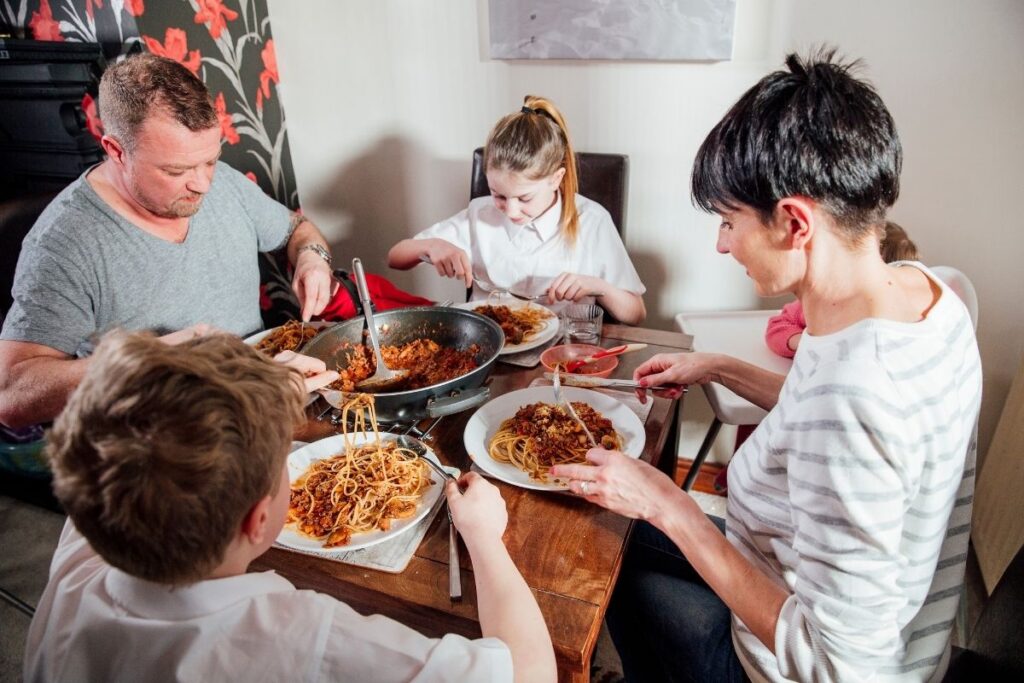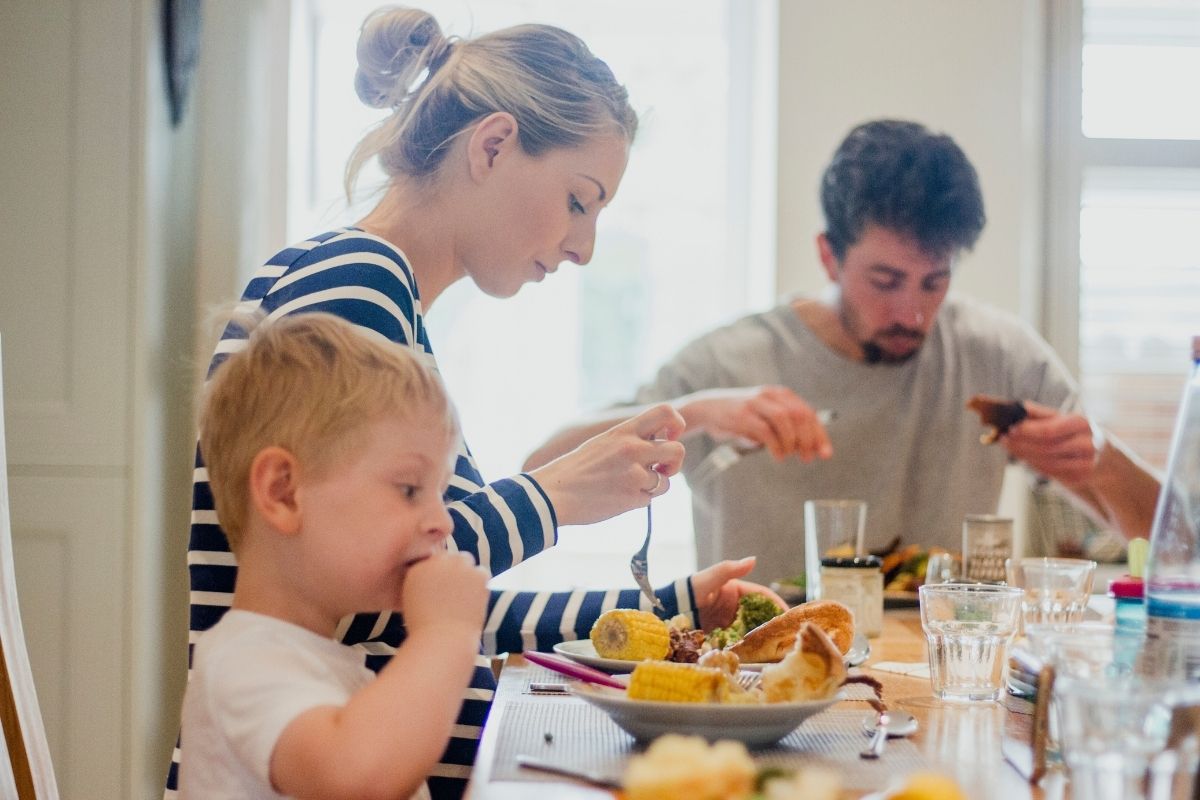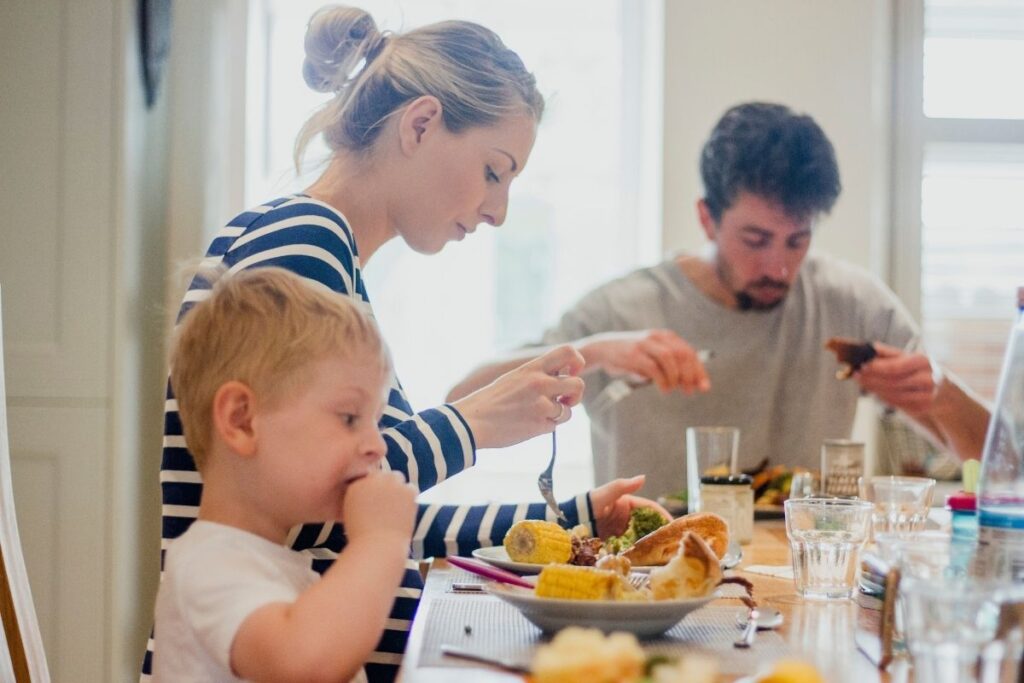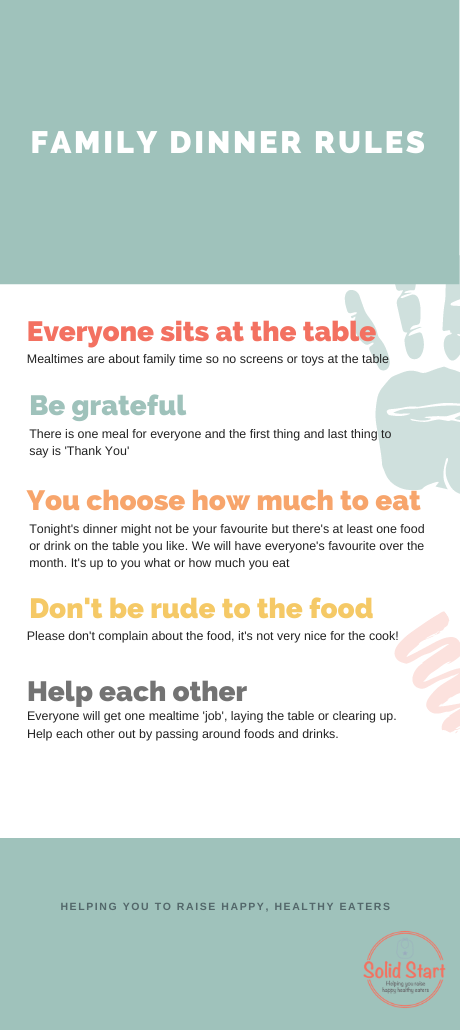You’re under pressure getting dinner on the table every night. But instead of gratitude, it’s tears, tantrums and the kids yelling yuck! In this blog, I want to share an easy and effective strategy to bring you from stressful to peaceful mealtimes. You have to try Family Dinner Rules.
Family meals can be challenging.
As a mum of four, I know how crazy, loud and stressful mealtimes can be. It’s terrible spending time planning, shopping and preparing food to meet complaints, demands and even tears. As well as not helping to create a positive mealtime experience for the kids, it ruins your enjoyment (not to mention digestion!) of the meal.
It’s probably why many parents choose to feed the kids first and eat themselves later after the kids’ bedtime.
Why do family meals at all?
So, we know that family meals aren’t always easy. And it’s tempting to separate kids and parents mealtimes. Then, why should we bother with family meals at all?
Because there are decades of research supporting family meals. Showing us that eating together offers a wide variety of physical, social, emotional and academic benefits. And while you can achieve some of these benefits with other activities, family mealtimes are the only single activity that provides all of them at the same time.
Children and adolescents who share family meals 3 or more times per week are more likely to:
- Be in a normal weight range
- Have healthier dietary and eating patterns (and less fussy eating)
- Are less likely to engage in disordered eating
And the benefits don’t stop with just physical and nutritional health.

Research also shows that frequent family meals are linked with less alcohol and substance use, violent behaviour, and feelings of depression or thoughts of suicide in adolescents. There is a positive relationship between frequent family meals and increased self-esteem and school success.
This means that it’s far more important for us to think about HOW we feed our family, rather than worrying about whether kids eat their vegetables!
Base your Family Dinner Rules on the Division of Responsibility
If you follow me on social media or read my other blogs, you’ll know that I’m a firm believer in the Division of Responsibility in feeding. This philosophy in feeding states that parents control When, Where and What foods are served, and kids control Whether to eat and How much. In my opinion, The Division of Responsibility in feeding should be the foundation for everyone’s family dinner rules.
Basically, it’s your job to provide the family meals; it’s the kids’ job to eat them (or not!).
It’s NOT your job to get the food from the table into your child’s mouth!
How do you create Family Dinner Rules?
This depends on your family and the ages of your kids. If your kids are in pre-school or Montessori, they might already be familiar with setting up these types of group contracts. For toddlers, you might talk about a few simple rules or even draw out some pictures to show how your family mealtimes should look.
There’s no right or wrong way to do this. And you’ll be surprised by how much even small kids can contribute with the right prompting!
Then you can print out your rules and display them where you eat your meals.
You don’t have to get the flip-chart out!
Our family dinner rules as an example!
Here are the dinner time rules that work for our family. Maybe you’ll want to add or remove rules from this. No problem, there’s no right or wrong, do what works for you.
The reasons behind our family dinner rules
Everyone Sits at the Table
As you’ve seen above, family meals are powerful. And much more important than the type of foods you serve at mealtimes. But to achieve those benefits, everyone in the family needs to sit down together at the table. So, even if my kids say they’re not hungry or don’t like what’s served, they know that they need to come to the table at mealtimes. Mealtimes are an important part of our family life, and it’s the norm that everyone is there.
Although, of course, there are exceptions! And with hectic work schedules, it’s not always possible to have both parents at the table. Pre-COVID and working from home, I mostly ate with the kids, and my husband ate later in the evening. However, one silver lining now is that he can usually take a break and join us for dinner making it more enjoyable for everyone, especially me!

You don’t have to eat.
This ties in with The Division of Responsibility in feeding. It’s your job to provide the meal, and it’s up to your child whether they eat it or not. Pressurising kids to eat DOES NOT work and generally has the opposite effect on the one you’re hoping for. So, telling the kids, ” you need to come and sit at the table, but it’s up to you what you eat”, is a great way to diffuse mealtime tensions.
Serving ‘family style‘ meals can also help to reinforce this low-pressure approach to mealtimes. But it’s important to be considerate (and reduce tantrums at the table) by making sure that there’s at least one food on the table that everyone likes. This doesn’t have to be their favourite, but it should be food they reliably eat when they’re hungry.
Be Grateful
Cooking family meals is a thankless task; the least everyone can do is say ‘thanks’ to the person who provided the food even if it’s not their favourite. This isn’t about guilting the kids into eating but helping kids feel gratitude. It’s also important that kids realise that not every night can be their favourite. On some days it’ll be their favourite meal but on others a brother or sister’s favourite. And of course, Mum and Dad should get to enjoy their favourites too.
Be kind
We ban the word ‘disgusting’ and ‘yuck’ from our table, although it still creeps in from time to time. Not only is this rude to the chef (me!), it also has adverse knock-on effects on the other kids. If you have a few children, I’m sure you might have been in the situation where one child is about to eat something when a sibling says yuck putting them off, and that’s unfair.
It’s fine by me if they don’t like a food, everyone’s opinion is relevant. But there are more polite ways to talk about food at the table.
No screens at the table
It’s tempting to give children an iPad or let them watch TV at the table so that they’ll eat more. But, doing this means you’re missing out on those important benefits of family meals times. There is countless research to support a non-screen policy at the meal table for adults and children alike.
Help each other
Firstly giving the kids jobs like laying the table or helping with food preparation helps give these a heads up that it’s almost dinner time. This makes the transition from play or TV time easier. Secondly, it teaches important life skills. Yes, it is often easier to do these tasks yourself but stick with it. It’ll pay off in the long term, I hope! It’s also a great low-pressure way of exposing kids to foods that they don’t like yet. Even carrying the bowl of carrots over to the table gets your child used to the smell, look and feel of them. And these are all important steps on the way to eventually tasting them.
Learn more about HOW and WHAT to feed children aged 1-5 years with my online Feeding Your Toddler course.
And why not subscribe to Solid Start and get tips on food, nutrition and feeding straight to your inbox every month?













0 Comments